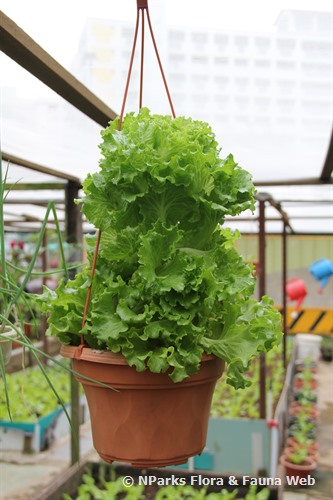
Name
Classifications and Characteristics
| Plant Division | Angiosperms (Flowering Seed Plants) (Dicotyledon) |
|---|---|
| Plant Growth Form | Herbaceous Plant |
| Lifespan (in Singapore) | Annual |
| Mode of Nutrition | Autotrophic |
| Maximum Height | 30 cm to 70 cm |
Biogeography
| Native Distribution | Asia Minor or Middle East |
|---|---|
| Native Habitat | Terrestrial |
| Preferred Climate Zone | Temperate |
| Local Conservation Status | Non-native (Horticultural / Cultivated Only) |
Description and Ethnobotany
| Growth Form | Annual or biennial herb up to 70 cm tall. |
|---|---|
| Roots | The root system is relatively small. |
| Foliage | Foliage varies widely according to cultivar type. In Singapore, headed cultivars may form loose heads or even no head at all, because temperatures are higher than optimal for lettuce. |
| Stems | The stem is often short in the head-forming cultivars, but grows up to 30-50 cm long among the stem lettuce cultivars. |
| Flowers | Compound flower known as a head is composed of 7-15 yellow florets. The heads are arranged in a branched inflorescence (known as a panicle) and has a flat top. |
| Fruit | Dry, indehiscent fruit is known as an achene. They are narrowly obovate (egg-shaped with the wider end at the tip), beaked, and attached to a pappus composed of 2 rows of soft, white hairs. |
| Cultivation | Lettuce is best grown in a temperate climate. In Singapore, it should be grown on consistently moist, but well-drained soils. It does not tolerate acidic soils (pH < 6). It takes about 2 months from sowing to first harvest. |
| Ethnobotanical Uses | Edible Plant Parts : Edible Leaves Food (Fruit or Vegetable): The leaves are eaten raw in salads and sandwiches. The Chinese and Taiwanese eat the fleshy stem of stem lettuce cultivars cooked. |
Landscaping Features
| Landscape Uses | Small Gardens, Container Planting |
|---|---|
| Thematic Landscaping | Economic Garden |
Plant Care and Propagation
| Light Preference | Full Sun |
|---|---|
| Water Preference | Lots of Water |
| Rootzone Tolerance | Moist Soils, Well-Drained Soils, Fertile Loamy Soils |
| Propagation Method | Seed |
| Seed / Spore Germination Duration | 4 days |
Foliar
| Foliage Retention | Evergreen |
|---|---|
| Mature Foliage Colour(s) | Green, Green - Light Green |
| Mature Foliage Texture(s) | Smooth, Thin |
| Prominent Young Flush Colour(s) | Green - Light Green |
| Young Flush Texture(s) | Smooth, Thin |
| Foliar Type | Simple / Unifoliate |
| Foliar Arrangement Along Stem | Spiral, Rosulate / Rosette |
| Foliar Attachment to Stem | Petiolate |
| Foliar Shape(s) | Non-Palm Foliage |
| Foliar Venation | Recticulate |
| Foliar Margin | Entire - Wavy / Undulate, Crenate |
| Foliar Apex - Tip | Rounded |
| Foliar Base | Cuneate |
Non - Foliar and Storage
| Stem Type & Modification | Herbaceous |
|---|---|
| Root Type | Underground (Tap Root) |
Floral (Angiosperm)
| Flower & Plant Sexuality | Bisexual Flowers |
| Flower Colour(s) | Yellow / Golden |
|---|---|
| Flower Grouping | Cluster / Inflorescence |
| Flower Location | Terminal |
| Individual Flower Shape | Ligulate / Strap-shaped |
| Inflorescence Type | Panicle, Head / Capitulum |
Fruit, Seed and Spore
| Mature Fruit Colour(s) | Brown |
|---|---|
| Fruit Classification | Simple Fruit |
| Fruit Type | Indehiscent Dry Fruit , Achene |
References
| References | Siemonsma, J.S. and Piluek, K. (Editors). 1994. Plant Resources of South-East Asia (PROSEA) No 8. Vegetables. Bogor, Indonesia: Prosea Foundation. |
|---|
Image Repository
Others
| Master ID | 31560 |
|---|---|
| Species ID | 5959 |
| Flora Disclaimer | The information in this website has been compiled from reliable sources, such as reference works on medicinal plants. It is not a substitute for medical advice or treatment and NParks does not purport to provide any medical advice. Readers should always consult his/her physician before using or consuming a plant for medicinal purposes. |






.jpg)
.jpg)
.jpg)


